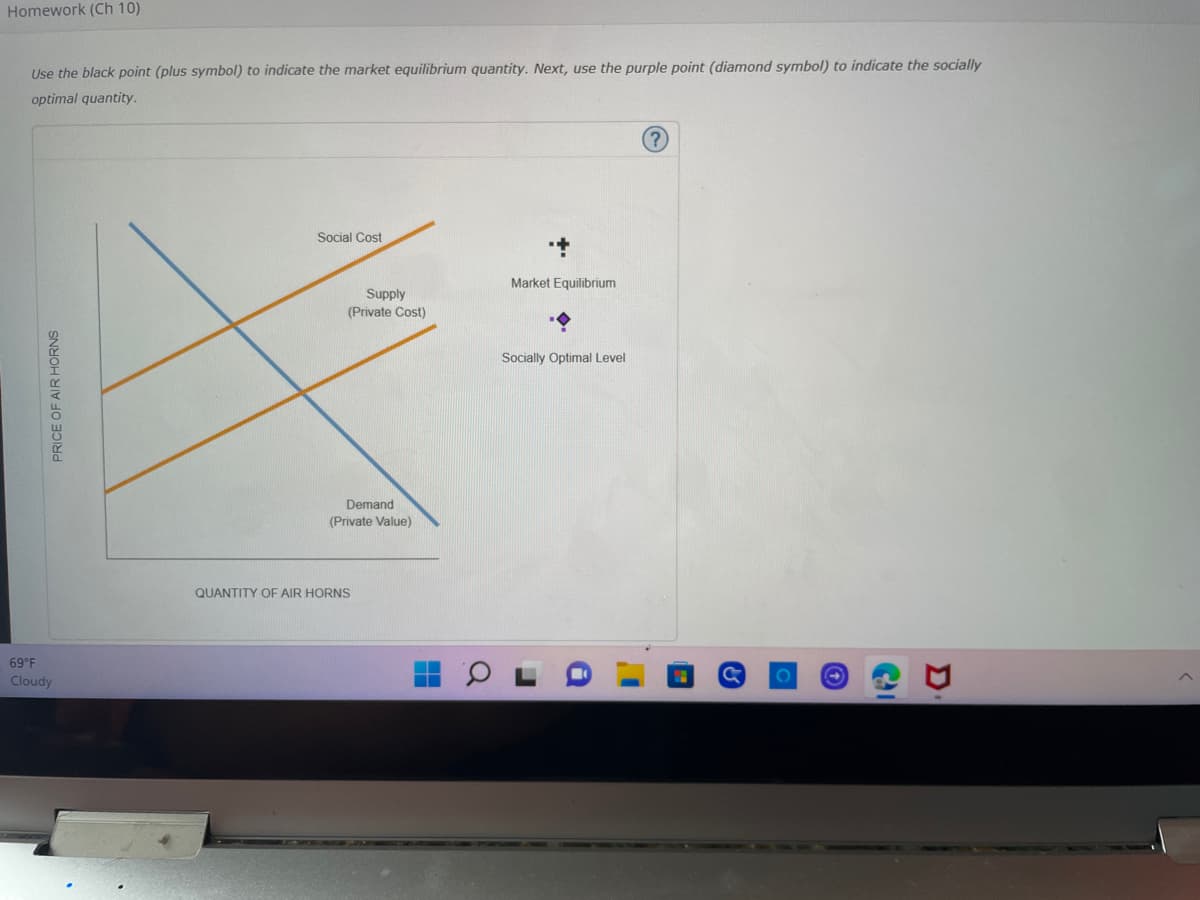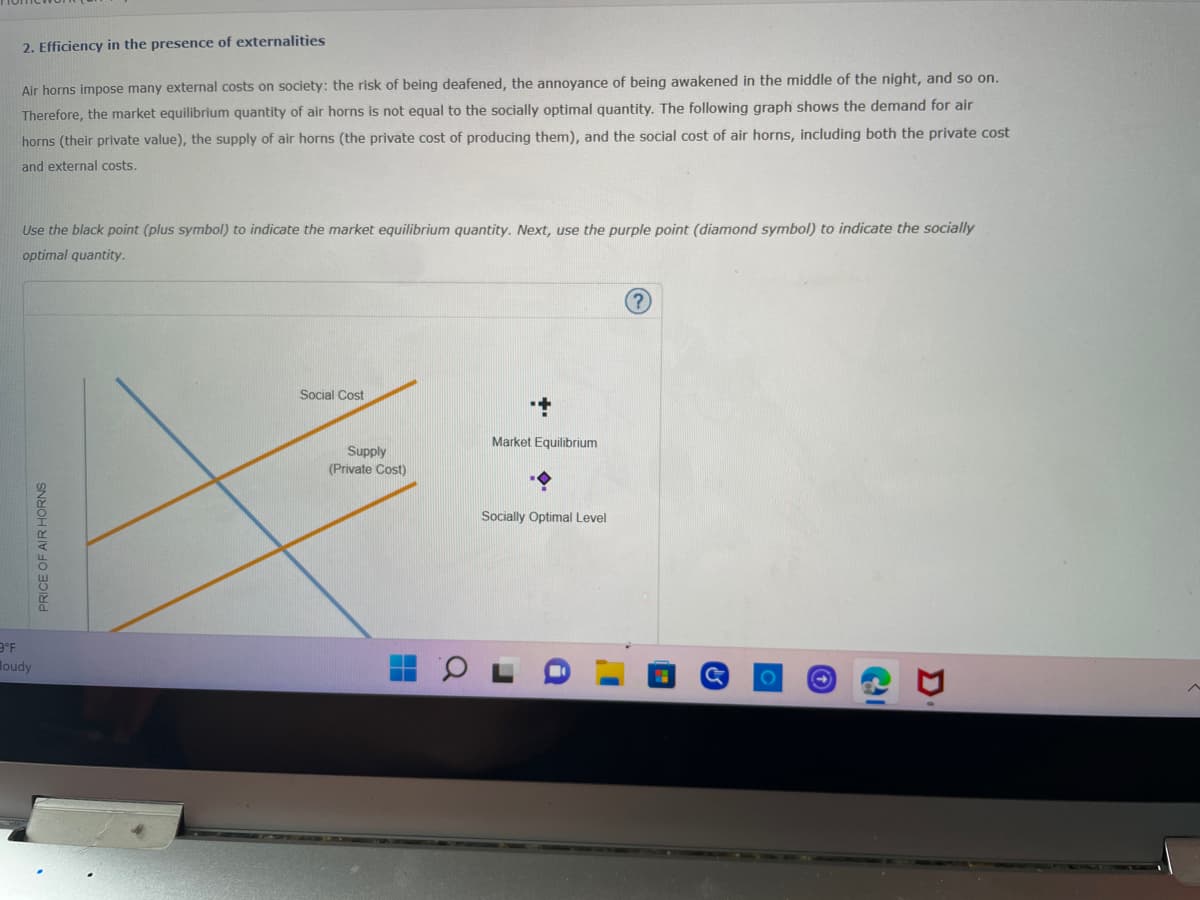Use the black point (plus symbol) to indicate the market equilibrium quantity. Next, use the purple point (diamond symbol) to indicate the socially optimal quantity. (? Social Cost PRICE OF AIR HORNS F oudy Supply (Private Cost) Demand (Private Value) QUANTITY OF AIR HORNS +|+| Market Equilibrium Socially Optimal Level C C
Use the black point (plus symbol) to indicate the market equilibrium quantity. Next, use the purple point (diamond symbol) to indicate the socially optimal quantity. (? Social Cost PRICE OF AIR HORNS F oudy Supply (Private Cost) Demand (Private Value) QUANTITY OF AIR HORNS +|+| Market Equilibrium Socially Optimal Level C C
Principles of Economics 2e
2nd Edition
ISBN:9781947172364
Author:Steven A. Greenlaw; David Shapiro
Publisher:Steven A. Greenlaw; David Shapiro
Chapter12: Environmental Protection And Negative Externalities
Section: Chapter Questions
Problem 40P: Show the market for cigarettes in equilibrium, assuming that there are no laws banning smoking in...
Related questions
Question

Transcribed Image Text:Homework (Ch 10)
Use the black point (plus symbol) to indicate the market equilibrium quantity. Next, use the purple point (diamond symbol) to indicate the socially
optimal quantity.
Social Cost
Market Equilibrium
Socially Optimal Level
PRICE OF AIR HORNS
69°F
Cloudy
Supply
(Private Cost)
Demand
(Private Value)
QUANTITY OF AIR HORNS
CI

Transcribed Image Text:3°F
2. Efficiency in the presence of externalities
Air horns impose many external costs on society: the risk of being deafened, the annoyance of being awakened in the middle of the night, and so on.
Therefore, the market equilibrium quantity of air horns is not equal to the socially optimal quantity. The following graph shows the demand for air
horns (their private value), the supply of air horns (the private cost of producing them), and the social cost of air horns, including both the private cost
and external costs.
Use the black point (plus symbol) to indicate the market equilibrium quantity. Next, use the purple point (diamond symbol) to indicate the socially
optimal quantity.
Social Cost
Market Equilibrium
Socially Optimal Level
oudy
PRICE OF AIR HORNS
Supply
(Private Cost)
D
Expert Solution
This question has been solved!
Explore an expertly crafted, step-by-step solution for a thorough understanding of key concepts.
This is a popular solution!
Trending now
This is a popular solution!
Step by step
Solved in 2 steps with 1 images

Knowledge Booster
Learn more about
Need a deep-dive on the concept behind this application? Look no further. Learn more about this topic, economics and related others by exploring similar questions and additional content below.Recommended textbooks for you

Principles of Economics 2e
Economics
ISBN:
9781947172364
Author:
Steven A. Greenlaw; David Shapiro
Publisher:
OpenStax



Principles of Economics 2e
Economics
ISBN:
9781947172364
Author:
Steven A. Greenlaw; David Shapiro
Publisher:
OpenStax




Exploring Economics
Economics
ISBN:
9781544336329
Author:
Robert L. Sexton
Publisher:
SAGE Publications, Inc

Principles of Microeconomics
Economics
ISBN:
9781305156050
Author:
N. Gregory Mankiw
Publisher:
Cengage Learning